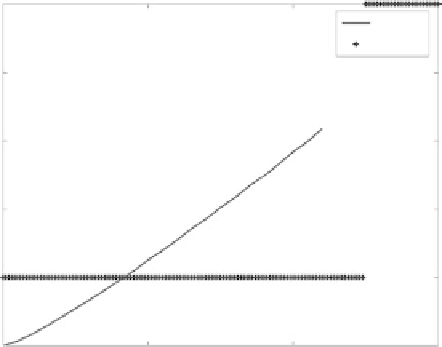Image Processing Reference
In-Depth Information
25
Hub
Switch
20
15
10
5
0
0
5,000 10,000
Kilobytes per second
15,000
FIGURE .
Packet delay as a function of node traffic for a hub and a switch []. Simulation results with baselines
(delay magnitudes) computed from experiments.
Although there are no message collisions on the networks, congestion may occur inside the switch
when one port suddenly receives a large number of packets from the other ports. If the buffers inside
the switch overlow, messages will be lost []. hree main queuing principles are implemented inside
the switch in this case. hey are first-in-first-out (FIFO) queue, priority queue, and per-flow queue.
The FIFO queue is a traditional method that is fair and simple. However, if the network traffic is
heavy, the network QoS for timely and fair delivery cannot be guaranteed. In the priority queuing
scheme, the network manager reads some of the data frames to distinguish which queues will be
more important. Hence, the packets can be classified into different levels of queues. Queues with
high priority will be processed first followed by queues with low priority until the buffer is empty.
With the per-flow queuing operation, queues are assigned different levels of priority (or weights). All
queues are then processed one by one according to priority; thus, the queues with higher priority will
generally have higher performance and could potentially block queues with lower priority [].
Thus, although switched Ethernet can avoid the extra delays due to collisions and retransmis-
sions, it can introduce delays associated with buffering and forwarding. his trade-off can be seen in
Figure ., which shows the average packet delay as a function of node traffic. The switch delay
is small but constant until the buffer saturates and packets must be resent; the hub delay increases
more gradually. Examples of timing analysis and performance evaluation of switched Ethernet can
be found in Refs. [,,,].
23.3.4.3 Industrial Ethernet
InaneforttopackageEthernettobemoresuitableforindustrialapplications,anumberof“industrial
Ethernet” protocols have emerged. hese include EtherNet/IP, Modbus/TCP, and PROFINET. While
these protocol specifications vary to some extent at all levels of the OSI model, they all fundamentally
utilize or recommend switched Ethernet technology as defined in the previous subsection. hus, the
differences in performance between Industrial Ethernet technologies lie more with the devices than
the protocols. For example in an effort to understand the trade-offs between Industrial Ethernet tech-
nologies, two common Industrial Ethernet protocols, EtherNet/IP and PROFINET, were compared in
the areas of architecture principles, technologies incorporated, performance, ease of use, diagnostics








